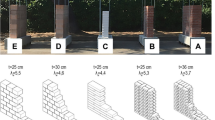Abstract
Many studies on the structural effects of corrosion in reinforcement have been conducted. However, most of them are based on artificially corroded test specimens. Thus, the knowledge available entails one major uncertainty, i.e. whether the results are reliable enough to be used for naturally corroded structures. The purpose of this study was to develop a test method and carry out experiments on naturally corroded specimens taken from an existing structure to investigate the anchorage capacity. Beam specimens were taken from the edge beams of a bridge at repair. The specimens showed corrosion-induced damage to a varying extent from no sign of corrosion to extensive cracking and spalling of the concrete cover. A four-point bending test indirectly supported by suspension hangers was chosen. The beams were strengthened with transverse reinforcement around the suspension hangers to avoid premature failure. Eight successful tests were carried out; in all these tests, diagonal shear cracks preceded a splitting induced pull-out failure; i.e. anchorage failure was achieved as intended. The results showed around 10 % lower capacity for the corroded specimens than for the reference ones. The average bond stress in the anchorage zone was estimated based on the applied load and available anchorage length. The stress was about 16 % lower in the beams with corrosion cracks, and 9 % lower in the beams with cover spalling compared to the reference specimens; there was also a larger variation among the damaged specimens than for the reference specimens. The results extend our knowledge concerning the structural behaviour of corroded reinforced concrete structures during field conditions.















Similar content being viewed by others
References
ASTM Standard G1-03 (2003) Standard Practise for Preparing, Cleaning and Evaluating Corrosion Test Specimens, ASTM International
Almusallam AA (2001) Effect of degree of corrosion on the properties of reinforcing steel bars. Constr Build Mater 15(8):361–368
Austin SA, Lyons R, Ing MJ (2004) Electrochemical behavior of steel-reinforced concrete during accelerated corrosion testing. Corrosion 60(2):203–212
Berg F, Johansson D (2011) Design of test set-up using FEM: Pilot tests on anchorage of naturally corroded reinforcement. Master of Science Thesis, Chalmers University of Technology, Göteborg
Cairns J, Plizzari GA, Du Y, Law DW, Franzoni C (2005) Mechanical properties of corrosion-damaged reinforcement. ACI Mater J 102(4):256–264
CEN (2005) EN 1992-1-1:2005. Eurocode 2: Design of concrete structures—Part 1: General rules and rules for buildings. European Committee for Standardization
Coronelli D, Gambarova P (2004) Structural assessment of corroded reinforced concrete beams: modeling guidelines. J Struct Eng 130(8):1214
Du YG, Clark LA, Chan AHC (2005) Effect of corrosion on ductility of reinforcing bars. Mag Concr Res 57(7):407–419
FIB (2000) Bond of reinforcement in concrete, State-of-art report. Fédération internationale du béton, prepared by Task Group Bond Models, Lausanne
Gestsdóttir E, Guðmundsson T (2012) Bond behaviour of naturally corroded reinforcement in concrete structures: experimental and numerical study. Master of science. Chalmers University of Technology, Göteborg
Jirsa JO, Chen W, Grant DB, Elizondo R (1995) Development of bundled reinforcing steel. Center for transportation research, Univeristy of Texas at Austin
Lundgren K (2005) Bond between ribbed bars and concrete. Part 2: the effect of corrosion. Mag Concr Res 57(7):383–395
Lundgren K, Magnusson J (2001) Three-dimensional modelling of anchorage zones in reinforced concrete. ASCE J Eng Mech 127(7):693–699
Saifullah M, Clark LA Effect of corrosion rate on the bond strength of corroded reinforcement. In: Swamy RN (ed) Proceedings of International Conference: Corrosion and corrosion protection of steel in concrete, University of Sheffield, 24–28 July 1994. Sheffield Academic Press, pp 591–602
Val DV, Chemin L, Stewart MG (2009) Experimental and numerical investigation of corrosion-induced cover cracking in reinforced concrete structures. ASCE J Struct Eng 135(4):376–385
Zandi Hanjari K (2010) Structural Behaviour of Deteriorated Concrete Structures. Doctoral Thesis, Chalmers University of Technology, Göteborg
Zandi Hanjari K, Lundgren K, Plos M, Coronelli D (2011) Three-dimensional modelling of structural effects of corroding steel reinforcement in concrete. Struct Infrastruct Eng 9(7):702–718. doi:10.1080/15732479.2011.607830
Author information
Authors and Affiliations
Corresponding author
Rights and permissions
About this article
Cite this article
Lundgren, K., Tahershamsi, M., Zandi, K. et al. Tests on anchorage of naturally corroded reinforcement in concrete. Mater Struct 48, 2009–2022 (2015). https://doi.org/10.1617/s11527-014-0290-y
Received:
Accepted:
Published:
Issue Date:
DOI: https://doi.org/10.1617/s11527-014-0290-y




